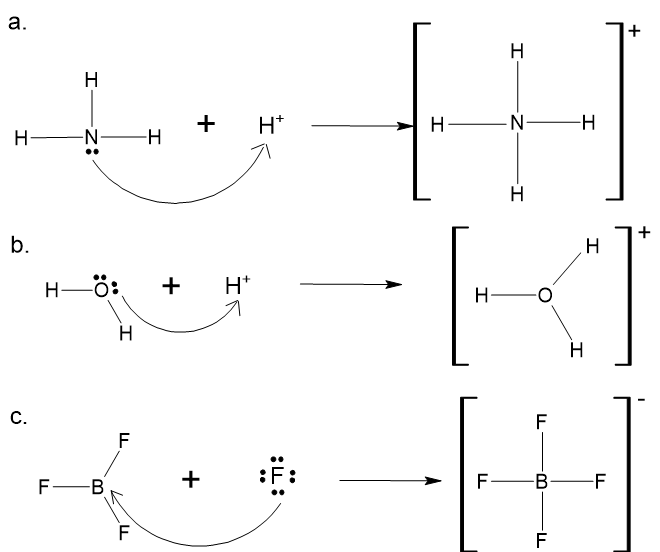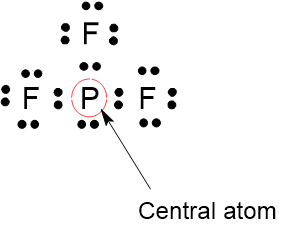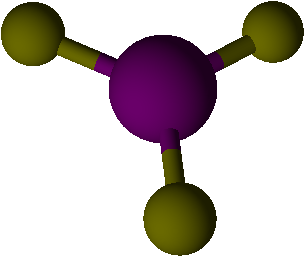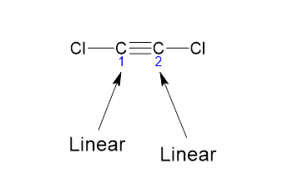Covalent bonds - exercises
\[\require{mhchem}\]
- Draw the Lewis structures for the following compounds:
\(\quad\)a. \(\ce{Cl}_{2}\)
\(\quad\)b. \(\ce{HI}\)
\(\quad\)c. \(\ce{PCl}_{3}\)
- Determine the molecular formulas of the following compounds by completing subscripts \(v,w,x,z\).
\(\quad\)a. \(\ce{H}_{x}\ce{S}\)
\(\quad\)b. \(\ce{CCl}_{z}\)a) \(x=2\). Electron configuration of \(\ce{S}\) is \(1s^{2}2s^{2}2p^{6}3s^{2}3p^{4}\). \(\ce{S}\) has six valence shell electrons. Therefore, \(\ce{S}\) needs two bonds to complete the valence octet. \(\ce{H}\) requires one single bond to acquire the noble gas configuration. Thus, \(\ce{S}\) forms two single bonds with two \(\ce{H}\) atoms (one bond each).
\(\quad\)c. \(\ce{PF}_{w}\)b) \(z=4\). C needs four bonds to acquire the valence shell octet. \(\ce{Cl}\) forms one covalent bond to achieve the valence shell octet. Therefore, one \(\ce{C}\) atom forms four single bonds with four \(\ce{Cl}\) atoms.
\(\quad\)d. \(\ce{HBr}_{v}\)c) \(w=3\). \(\ce{P}\) belongs to main group \(V\) of the periodic table. Therefore, it requires three covalent bonds to achieve the valence shell octet. \(\ce{F}\) is a halide from main group \(VII\) of the periodic table. Hence \(\ce{F}\) needs one covalent bond to acquire the octet. \(\ce{P}\) forms three single bonds with three \(\ce{F}\) atoms.
- The following compounds contain multiple bonds. Identify the positions of the multiple bonds and draw the structure.
\(\quad\)a. \(\ce{C}_{2}\ce{H}_{4}\)
\(\quad\)b. \(\ce{N}_{2}\)
\(\quad\)c. \(\ce{SO}_{3}\)
\(\quad\)d. \(\ce{HCN}\)
- Use the knowledge of coordinate covalent bonds and explain the formation of the following polyatomic ions
\(\quad\)a. Formation of \(\ce{NH}_{4}^{+}\) by the reaction between \(\ce{NH}_{3}\) and water \(\left(\ce{H}^{+}\right)\)
\(\quad\)b. Formation of \(\ce{H}_{3}\ce{O}^{+}\) by the reaction between \(\ce{H}_{2}\ce{O}\) and \(\ce{H}^{+}\)
\(\quad\)c. Formation of \(\ce{BF}_{4}^{-}\) by the reaction between \(\ce{BF}_{3}\) and \(\ce{F}^{-}\)
In all of these molecules, a coordinate covalent bond is formed between an empty orbital of one atom with a lone pair of another atom. In the ammonium ion (\(\ce{NH}_{4}^{+}\)), the nitrogen atom of ammonia donates a lone pair of electrons to the hydrogen cation, which has an empty \(1s\) orbital. In a hydronium ion, the oxygen atom in the water molecule is donating one of their lone pairs to the hydrogen cation with a vacant \(1s\) orbital. In \(\ce{BF}_{4}^{-}\) ion, the fluoride anion donates one of their lone pairs to an empty \(2p\) orbital of the boron atom of \(\ce{BF}_{3}\) which gives boron four covalent bonds.

- Predict the geometry of the following molecules
\(\quad\)a. \(\ce{PF}_{3}\)
\(\quad\)b. \(\ce{SCl}_{2}\)
\(\quad\)c. \(\ce{SiBr}_{4}\)
a. Step 1 - Draw the Lewis structure of the molecule and identify the central atom.

Step 2 - Sum up the number of bonds and lone pairs in the central atom to get the total number of electron clouds around the central atom
\(\ce{P}\) has three covalent bonds and one lone pair of electrons. Therefore, all electron clouds around the central atom are 4.
Step 3 - Anticipate the shape of the molecule based on the number of electron clouds around the central atom
Total number of electron clouds = 4
So the shape can be tetrahedral, pyramidal or angular. Since one of the electron clouds is a lone pair, the best choice would be pyramidal.

b. Angular/Bent
c. Tetrahedral
- Predict the geometry around each of the carbon atoms in \(\ce{C}_{2}\ce{Cl}_{2}\).
- Predict the geometry of the following polyatomic ions
\(\quad\)a. \(\ce{NH}_{2}^{-}\)
\(\quad\)b. \(\ce{CO}_{3}^{2-}\)
\(\quad\)c. \(\ce{SO}_{4}^{2-}\)
b. Trigonal planar
c. Tetrahedral
- The structure and 3D view of the amino acid Aspartic acid is shown below. Predict the geometry around the indicated carbon atoms.

- Determine whether the following bonds are ionic, polar covalent or covalent
\(\quad\)a. Between \(\ce{S}\) and \(\ce{Cl}\)
\(\quad\)b. Between \(\ce{N}\) and \(\ce{H}\)
\(\quad\)c. Between \(\ce{C}\) and \(\ce{Br}\)
\(\quad\)d. Between \(\ce{Li}\) and \(\ce{F}\)
| Electronegativity difference | Type of bond |
|---|---|
| \(\geqslant2.0\) | Ionic |
| \(0.5-1.9\) | Polar covalent |
| \(0-0.4\) | Covalent |
\(\quad\)b. Polar covalent
\(\quad\)c. Covalent
\(\quad\)d. Ionic
- Predict the polarity (polar or nonpolar) of each of the following molecules.
\(\quad\)a. \(\ce{HCN}\)
\(\quad\)b. \(\ce{NH}_{3}\)
\(\quad\)c. \(\ce{CH}_{3}\ce{Br}\)
\(\quad\)a. \(\ce{HCN}\) has a linear geometry. The \(\ce{C}-\ce{H}\) bond is a covalent bond (EN difference is \(0.35\), non-polar bond). The \(\ce{C}-\ce{N}\) bond is almost a polar covalent bond (EN difference is \(0.49\)). Therefore, electrons are attracted strongly towards the nitrogen atom in the \(\ce{C}-\ce{N}\) bond, creating a net polarity in the molecule.
\(\quad\)b. Polar molecule \(\quad\)c. Polar molecule



